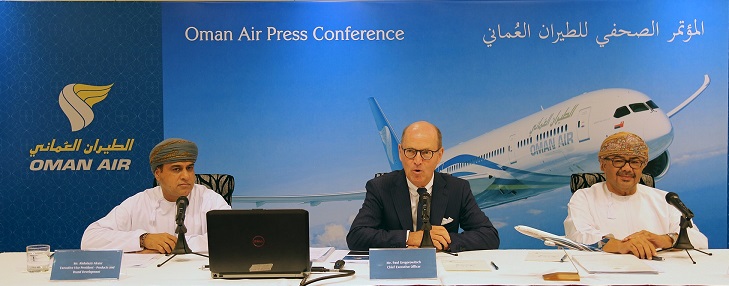Oman Air’s Chief Executive Officer, Paul Gregorowitsch, has delivered a key report on the airline’s progress and plans for continued expansion at a press conference, held on 27th September 2016 in Oman Air’s Catering hall near Muscat International Airport.
Gregorowitsch stated that Oman Air’s vision is “To Become the Best”, and that its objectives are to be a safe airline, to be the airline of First Choice, to make money by increasing revenues and reducing costs, to cater for growth as set out in the company’s ten-year plan, and to contribute to the development of the Sultanate.
“I am pleased to report that Oman Air has achieved important progress over the last two years and I am optimistic about the company’s future,” he said. “With the invaluable support of Oman Air’s Board of Directors, we have a clear vision, achievable objectives and a set of values to which all our employees are committed. We are also delivering an ambitious and dynamic programme of fleet and network expansion. This has seen the company take delivery of outstanding new aircraft, introduce a range of exciting new destinations and launch new products and services which contribute to a seamless passenger experience.”
Oman Air’s fleet expansion programme has already made significant progress. With the first of the new aircraft being delivered in the last quarter of 2014, Oman Air fleet size stood at 35 aircraft by January 2015. One year later, in January 2016, the fleet had increased in size to 41 aircraft. Currently Oman Air’s fleet consists of four Boeing 787 Dreamliners, six Airbus 330-300s, four Airbus 330-200s, five Boeing 737-900s, 21 Boeing 737-800, one Boeing 737-700 and four Embraer 175s.
Oman Air’s fleet size stands at 45 aircraft, with at least two more B737s expected to be delivered before the end of the year, and four more B787s due for delivery over the next two years.
Gregorowitsch also described how Oman Air’s network has grown in parallel with its fleet expansion. Recent international destinations to be added to the airline’s network include Manila, Jakarta, Singapore, Goa, Dhaka and Mashhad, Guangzhou in China will be launched on December 9, 2016. Frequencies have also been increased on many established routes, including Frankfurt, Paris, Zurich and London, whilst all Indian destinations now enjoy at least daily or double-daily services. In addition, Oman Air will be launching Manchester, its second destination in the UK, in its Summer 2017 schedule.
Customer choice has been further broadened through the strategic use of codeshare agreements with airlines that share Oman Air’s commitment to quality. The company currently operates codeshare partnerships with Emirates Airlines, Ethiopian Airlines, Royal Jordanian, Turkish Airlines, Sri Lankan Airlines, KLM Royal Dutch Airlines, Garuda Airlines, Saudia and Thai Airways.
[caption id="attachment_34557" align="aligncenter" width="729"] Oman Air reports on progress & future plans[/caption]
Oman Air reports on progress & future plans[/caption]
Gregorowitsch stated that the airline currently has no plans to seek membership of one of the global airline alliances, but is developing some tactical partnerships.
Additional investments in a forthcoming new crew village at Muscat, crew reporting, flight simulators, headquarters infrastructure and management information systems are facilitating more efficient and effective delivery of Oman Air’s services, added Gregorowitsch.
Such investments have been made against a challenging economic background, warned Oman Air’s CEO. Year-on-year reductions in the levels of support offered to Oman Air by the government in 2014, 2015 and 2016 are set to continue and over-capacity within the air travel market is driving prices down, leading to a cut in potential yields. Fleet and network expansion has seen a parallel expansion in the number of staff employed internationally, resulting increases in payroll and on-costs. However, an important positive outcome is that the proportion of Omani citizens employed by Oman Air has continued to grow and now stands at 64 per cent, underlining the airline’s ongoing commitment to Omanisation.
In conclusion, Gregorowitsch expressed his concern regarding the existing infrastructure at Muscat Airport which is affecting the growth initiatives of the National airline. He clearly identified the need to have a second runway available as soon as the new passenger terminal is inaugurated to cater for the planned growth and ongoing contribution to the national economy.

